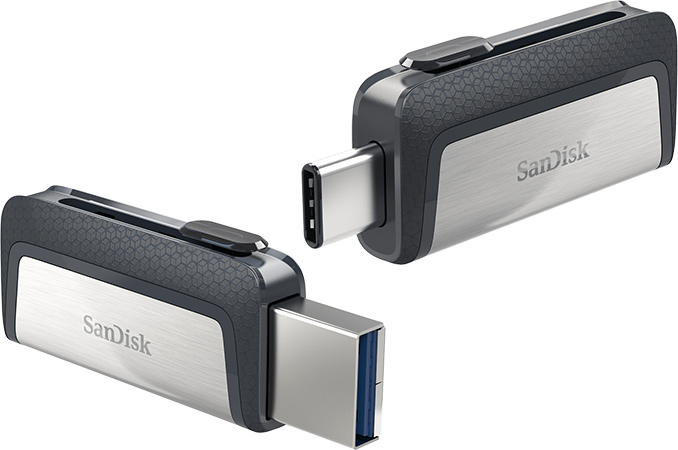SanDisk Unveils New Generation of USB Type-C Flash Drives
by Anton Shilov on June 1, 2016 2:00 PM EST- Posted in
- Computex_2016
- Flash Drive
- SanDisk
- Trade Shows
- USB-C

Last year SanDisk released its first-gen USB flash drives featuring two types of connectors: USB-A and USB-C in a bid to address the growing market of devices featuring USB Type-C, but retain compatibility with billions of legacy devices. This year, SanDisk introduced a new generation of such drives with adifferent design and higher-capacity options.
The second-generation SanDisk Ultra Dual Drive USB Type-C family of USB flash drives includes models with 16 GB, 32 GB, 64 GB and 128 GB of NAND memory. The drives offer transfer speeds up to 150 MB/s and are compatible with all devices featuring USB-A and USB-C receptacles. Furthermore, they are also compatible with SanDisk’s Memory Zone app for Google Android to manage and backup content on devices running the OS.
| SanDisk Ultra Dual Drive USB Type-C Family | |||||||||
| 16 GB | 32 GB | 64 GB | 128 GB | ||||||
| Model (U.S./Europe) | SDDDC2-016G-A46 SDDDC2-016G-G46 |
SDDDC2-032G-A46 SDDDC2-032G-G46 |
SDDDC2-064G-A46 SDDDC2-064G-G46 |
SDDDC2-128G-A46 SDDDC2-128G-G46 |
|||||
| Interface | USB-A, USB-C, 5 Gbit/s | ||||||||
| Sequential Write | 130 MB/s | 150 MB/s | |||||||
| Warranty | 5 Years | ||||||||
| Price | $19.99 | $29.99 | $39.99 | $69.99 | |||||
| Launch Date | Q2 2016 | ||||||||
Introduced commercially in 2015, the USB Type-C connector is rapidly gaining traction among suppliers of PCs, smartphones, tablets and other electronics. For manufacturers of peripherals adoption of new ports by devices is an important factor because they want to address broader audiences with their products. While USB Type-C is gaining popularity, there are still way too many systems featuring USB Type-A ports, which is why it makes a lot of sense to build peripherals compatible with both types of USB.
Moreover, analysts from Strategy Analytics believe that even by 2020 only about 44% of mobile phones will use USB-C, which is a remarkable growth, but which still means that 56% of mobile phones will keep using other types of connectors.
SanDisk and its partners are already selling the new drives with 16GB, 32GB, 64GB and 128GB capacities for U.S. MSRPs of $19.99, $29.99, $39.99 and $69.99, respectively.
Source: SanDisk















25 Comments
View All Comments
A Serious Man - Friday, June 3, 2016 - link
You would only need 5%.5% of phones with both would count as +5% of phones using USB-C and +5% of phones using other interfaces.
A Serious Man - Friday, June 3, 2016 - link
Altough bug77 down there is right. They would have already been counted in the base percentage.Man, we went too far...
jayfang - Friday, June 3, 2016 - link
Just like these drives prediction is for dual connector phones with both micro & type-C....or maybe not ;-)
digiguy - Wednesday, June 1, 2016 - link
Waiting for a flash drive that can use the 10GB/s bandwidth of Gen 2 to upgrade my Voyager GTX....samer1970 - Thursday, June 2, 2016 - link
first you mean 10Gb not GB ,second ,
no one will make a 10Gb/s stick forget it ...
azazel1024 - Thursday, June 2, 2016 - link
Yeah, that is going to be a long time. The best of the best isn't fully saturating 5Gbps still. Yes, the Voyager just about can, but it is still a little bit short (5Gbps with encoding, etc. works out to roughly 500MB/sec).It also means more heat, more expense, etc. Some day, sure, just don't expect it for a few more years, especially when relatively few computers have 10Gbps USB3.1 ports.
Lastly, if you really need 10Gbps, there is the Sandisk Extreme 900. That is pretty much it.
fazalmajid - Wednesday, June 1, 2016 - link
I wish they made a 256GB and 512GB version, to use as a proper backup drive for my MacBook, instead of the Samsung T3 I use currently (very fast but a little bulky).I have a Sony drive with dual ports (no slider) which seems more compact than this one, but it doesn't have the slider, overheats quickly and tops out at 64GB.
samer1970 - Thursday, June 2, 2016 - link
flash sticks are not good for backup .they can get corrupted very easy.HomeworldFound - Wednesday, June 1, 2016 - link
My new phone has a Type-C port and I have 32GB memory, 128GB memory card and would like a 128GB flash drive too, but at least on Android most of the manufacturers still insist on using FAT/FAT32. At this point this is unacceptable.Byciek - Wednesday, June 8, 2016 - link
Yes and no.While Android itself doesn't support NTFS, you can use File Manager app (like ES File Explorer in my case) to gain read access (I didn't tray any write operations yet).